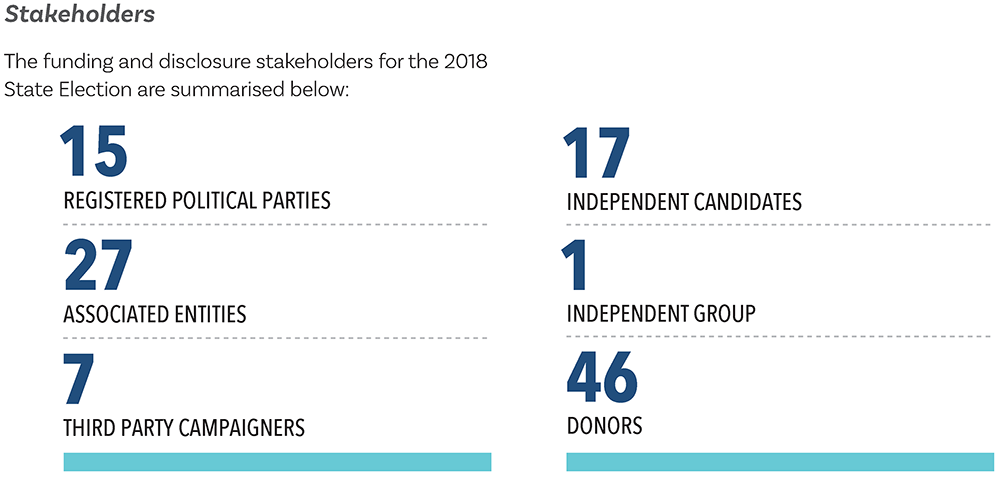INTRODUCTION
This election saw an upswing in both the number of electors enrolled to vote and the number of nominations lodged. While encouraging, the increase in enrolled electors masks a declining rate of youth enrolment.
In this chapter, topics include the electoral redistribution, legislative changes, the issue of the writs, enrolment, and nominations for both houses of Parliament. We also introduce the new funding and disclosure arrangements which are covered in more detail in Chapter Six and provide information about party registration. All of these elements set the scene for the 2018 State Election.
ELECTORAL REDISTRIBUTION
After every state election, South Australia’s independent Electoral Districts Boundaries Commission (EDBC) examines the boundaries of the House of Assembly electoral districts to ensure that South Australian electors continue to have effective representation as demographics change. Serving on the three-person 2016 EDBC were the Chair, the Honourable Justice Ann Vanstone (senior puisne Judge of the Supreme Court), Mr David Gully (the Acting Electoral Commissioner) and Mr Michael Burdett (the Surveyor-General).The EDBC published its Order on 7 December 2016 in which it altered all but one of the state’s House of Assembly districts (Mount Gambier). Boundaries were redrawn – substantially in some areas – with the goal of redistributing the population relatively equally, maintaining communities of interest to the extent possible, and as far as practicable, to achieve a parliamentary majority for the party that won the two-party preferred vote.
The redistribution resulted in around 400,000 electors changing electoral districts and a further 81,000 electors in seven districts having their districts renamed. These seven districts were:
- Badcoe (formerly Ashford)
- Black (formerly Mitchell)
- Elizabeth (formerly Little Para)
- Gibson (formerly Bright)
- Hurtle Vale (formerly Fisher)
- King (formerly Napier)
- Narungga (formerly Goyder)

ABOVE, ECSA’S INTERACTIVE BOUNDARIES MAP, 2014 BOUNDARIES IN BLUE, 2018 IN RED.
Despite ECSA’s own efforts to publicise the
unprecedented scale of the 2016 redistribution
and its impact on electors through the interactive
map and the distribution to every enrolled elector
of an EasyVote Card detailing their electoral district,
many South Australians remained unaware of the
changes ordered by the EDBC.
According to ECSA's 2018 Surveys of Electors,
only one in three electors (32%) were aware of
whether their district had changed or not since the
2014 State Election. Among electors who were aware
of the redistribution, there was broad ignorance
about why it had been ordered, with significant
proportions blaming gerrymandering (28%) or unable
to provide an explanation (33%).
Many electors were under the impression that ECSA
had been responsible for the boundaries redraw.
This misperception contributed to a decrease in
the number of electors who felt that ECSA had
conducted the State Election impartially from 93%
in 2014 to 79% in 2018. The most frequently given
reason for this change was a perception that the
boundaries redistribution had been unfair.
Confusion over who is responsible for redrawing
boundaries points to a need for the EDBC to do more
to raise public awareness about any future changes
it orders to boundaries. ECSA intends to discuss
with the Chair of the EDBC the need to directly
inform all residents of areas affected by boundary
redistributions about the changes it orders and the
reasons for those changes.
LEGISLATIVE CHANGES
The Act gives effect to South Australians’ right to
vote in state elections by setting the framework for
the state electoral process. ECSA conducts state
elections in accordance with its provisions.
A range of electoral reforms enacted by the
South Australian Parliament since 2014 had an
impact on the conduct of the 2018 State Election.
Major changes included the following (with a
complete list available in Appendix 3):
Changes to the method of voting for the
Legislative Council
Optional preferential voting was introduced for the
Legislative Council. This allowed electors to either
mark preferences above the line for more than
one group, or to vote below the line by marking a
minimum of 12 preferences for candidates instead of
having to preference all candidates below the line as
previously required.
Abolition of ticket voting for the
Legislative Council
Group voting tickets for Legislative Council elections
were removed from the Act in 2017, meaning that
political parties or groups contesting the elections no
longer determine the preference flow for above-the-line
votes cast for that party or group.
Reduction of the deposit paid by House
of Assembly candidates
From 2018, candidates nominating for election to
the House of Assembly needed to pay a deposit of
$1,000, a significant reduction from the previous
$3,000. Another amendment to the Act meant
that cash was no longer acceptable as a method of
payment for a nomination deposit.
Electronically assisted voting for vision-impaired
electors
Electronically assisted voting was authorised to
allow electors whose vision is impaired to vote
independently at state elections without seeking
assistance. This provided this category of electors
with the means of casting an independent and
secret ballot (Chapter
Four).
Obligation to promote voting at a polling
booth on polling day
An obligation was placed on the Electoral
Commissioner to promote and encourage the
casting of votes at a polling booth on polling day.
This is discussed in further detail in Chapter Four.
ISSUE OF THE WRITS
The trigger for a state election is the issue of the
writs, which occurs 28 days before polling day.
On Saturday 17 February 2018, the Governor of
South Australia, His Excellency the Honourable
Hieu Van Le AC, proclaimed the prorogation
of Parliament and dissolution of the House of
Assembly and issued writs for the 2018 State
Election. One writ was issued for the election of
the 47 Members of the House of Assembly and
another for the election of 11 Members of the
Legislative Council.
The writs set out the timetable for the election and
provided the Electoral Commissioner with 74 days to
successfully complete the elections before the writs
had to be returned to the Governor.
ENROLMENT
At the close of rolls on Friday 23 February 2018,
1,201,775 electors were registered on the state
electoral roll and eligible to vote at the State Election,
a significant increase of 5.2% from the 2014 Election
and the largest ever roll for a South Australian election.
This increase reflects population growth, the effects
of the federal direct enrolment program and a surge
of enrolments in 2017 for the Australian Marriage Law
Postal Survey. The average number of electors per
House of Assembly electoral district was 25,570, with
the highest number of electors enrolled in Elizabeth
(28,399) and the lowest in Flinders (22,756).
South Australians responded positively to ECSA's calls for enrolment with
approximately 25,000 enrolments and updates effected in the month leading up to
the close of rolls. During the six days from the issue of the writs to the close
of the rolls there were approximately 11,900 enrolments and updates to the
electoral roll, representing a decrease of 20.6% from the same period in 2014.
Despite this success, a breakdown of the electoral
roll by age groups shows that a significantly high
proportion of younger South Australians were not on
the roll for the Election.
An estimated 37.4% of eligible 18-year-olds (up from
31.9% in 2014) and an estimated 13.2% of all eligible
18 to 24-year-olds were not enrolled to vote. These
estimates of electors against the voting eligible
population were calculated by the AEC by reducing
an estimate of non-eligible persons from the total
population. However, for consistency with past
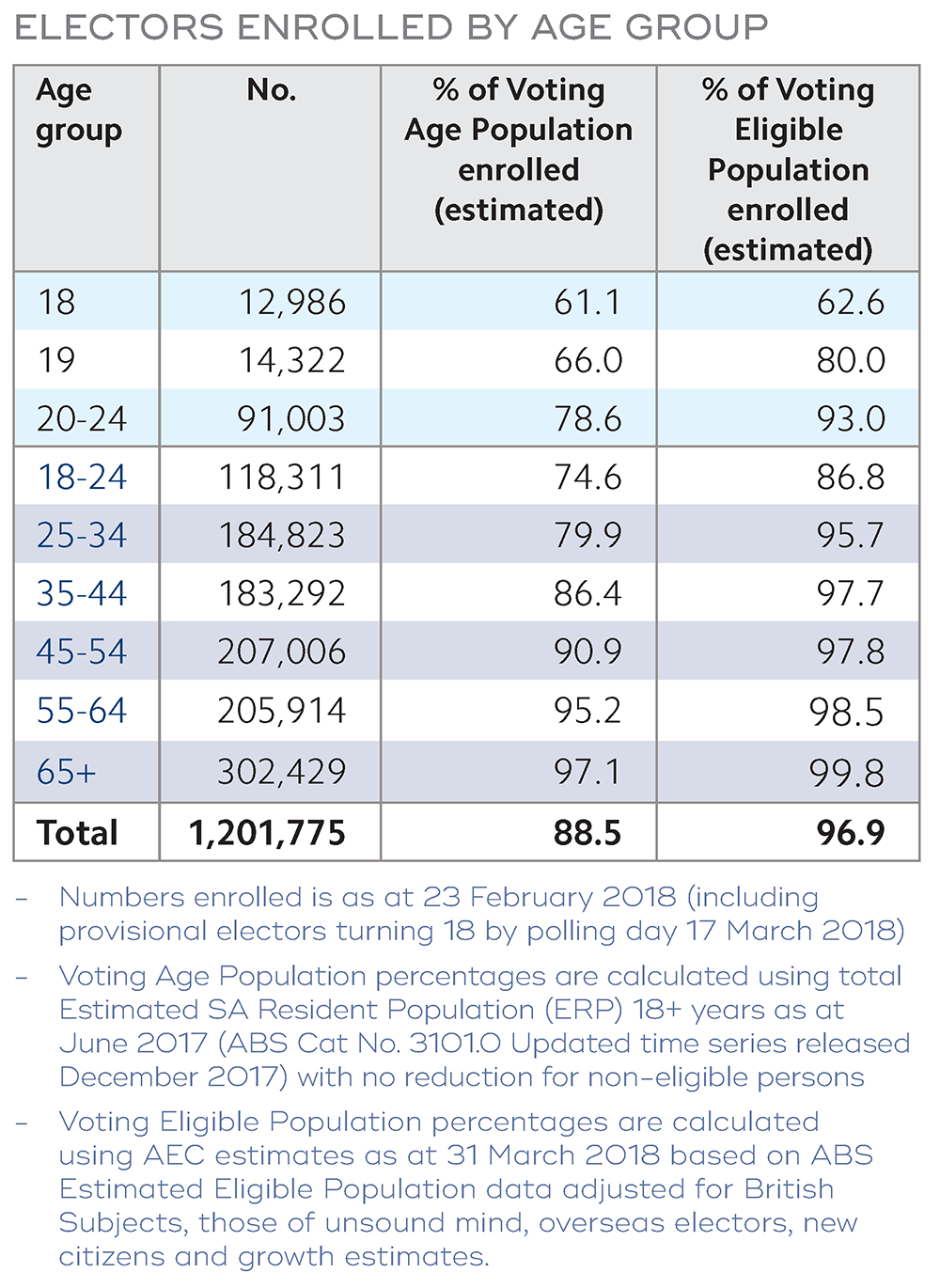
ECSA believes there is more work to be done to
improve enrolment levels among young people,
citizens from culturally and linguistically diverse
(CALD) backgrounds and Aboriginal South
Australians, including those living in the APY Lands
and other remote communities.
To counter the lower rate of enrolment among
these groups, ECSA plans to look for opportunities
to further enhance its enrolment strategy ahead
of the next State Election. This will support a
comprehensive enrolment drive in collaboration
with the AEC which includes targeted engagement
activities for underrepresented sectors of the
population such as young people, CALD groups
and Aboriginal citizens. ECSA’s efforts to build
engagement with electors in CALD and Aboriginal
communities are discussed in more detail in Chapter
Three of this Report.
A CALL FOR LEGISLATIVE CHANGE: ENROLMENT ON THE DAY
The declining rate of enrolment of younger electors
and the increasing numbers of non-voters are a
matter of concern not isolated to South Australia.
Indeed, there has been longstanding unease about
both trends among electoral commissions and
commentators in Australia, New Zealand and
further afield.
One of the solutions to address falling participation
rates successfully implemented by ECSA’s
counterparts in New South Wales (NSW), New
Zealand (NZ), Queensland and Victoria (as well as
most Canadian jurisdictions) has been to allow
people to enrol after the close of rolls. Although the
commissions of these jurisdictions continue to have
and to advertise a close of rolls, they allow enrolment
on the day as a ‘savings provision’ to enfranchise
people who inadvertently miss the close of rolls.
This helps avoid the situation at each election where
thousands of people turn up to polling booths and
are told they are not on the roll and cannot vote.
ECSA did not record the number of people who
attended a polling place at the 2018 State Election
and walked away when told they were not on the
roll, but we are aware from polling official feedback
that there were many potential electors in this
circumstance. Records were kept of those who
insisted on casting a vote, claiming there must
have been an error with the roll. Of the 7,318 people
who did so in 2018, just 153 (2%) had their House
of Assembly vote counted and 852 (12%) their
Legislative Council vote counted, after investigation
of their enrolment.
NSW (since 2011) and Victoria (since 2010) permit
enrolment up to and including on polling day.
NZ (since 2005) and Queensland (since 2017) allow
enrolment and voting during the early voting period
but not on polling day itself - although Elections NZ
is currently investigating extending enrolment to
polling day.
The Victorian and NSW electoral commissions
consider enrolment on the day a success. In both
jurisdictions, the number of voters who have made
use of this provision has significantly increased:
in NSW from 20,960 in 2011 to 41,978 in 2015; in
Victoria from 34,546 in 2010 to 50,653 in 2014. In NZ,
where late enrolment has been in place longer, there
has been an even more significant rise in enrolments
after the close of rolls: from 35,363 in 2005 to
130,757 in 2017 (including 53,000 at pre-poll centres).
Given the success of late enrolment options
elsewhere in Australasia, ECSA seeks legislative
change to bring South Australia into line with other
jurisdictions and allow eligible electors to enrol up to
and on polling day. Although ECSA would continue
to actively promote the close of rolls, enrolment on
the day would be a savings provision to help ensure
that as many South Australians as possible can
participate in state elections.
That the Act be amended to enable eligible electors to enrol up to and on polling day. After claiming enrolment, these electors would be allowed to cast declaration votes which would not be admitted to the count until an enrolment investigation had been satisfactorily completed in the week after polling day.
A CALL FOR LEGISLATIVE CHANGE: ITINERANT ELECTORS
There is broad consensus in Australia that the lack
of a permanent residential address should not
disenfranchise people from voting. All Australian
jurisdictions, including South Australia, provide a
special category of enrolment for people who do
not have a fixed address. Broadly speaking, two
categories of citizens are covered by the ‘itinerant
electors’ enrolment category: people experiencing
homelessness and people who are long-term
travellers within Australia who do not have a
permanent address to return to (some of whom
are referred to colloquially as ‘grey nomads’).
Before the 2018 State Election, ECSA’s stakeholder
partners from the homeless sector raised concerns
during consultation that by encouraging their clients
to enrol as itinerant electors and participate in the
Election, they could be setting them up for failure.
Concern centred on the fact that under the Act while
enrolment is not compulsory for itinerant electors,
voting is compulsory. If a homeless person takes
the positive step of enrolling as an itinerant elector,
and then for whatever reason does not vote at an
election, they will be issued with a failure to vote
notice which they will be unlikely to receive given
their lack of a fixed address. A failure to respond
will then become a fine which left unpaid leads to
accumulated late payment fees and potentially
court action. As stakeholders pointed out, far from
connecting homeless people with the democratic
process, the current system is likely to exacerbate
the fears and suspicion that many hold towards
government.
To resolve this issue and remove the barriers
to electoral participation by homeless people,
other jurisdictions including the Commonwealth
and NSW have amended legislation to exempt
itinerant electors from compulsory voting. This
allows electoral commissions in these jurisdictions
to encourage homeless people to enrol and vote
without fear of consequences if they fail to do so.
ECSA recommends legislative change to harmonise
South Australia’s legislation with the Commonwealth,
and exempt itinerant electors from compulsory
voting at state elections. This requires Parliament to
add being an itinerant elector to section 85(8) of
the Act.
ECSA also seeks legislative changes to section
31A(10) of the Act so that itinerant electors who fail
to vote at a state election or who remain outside
the state for a period of more than one month are
not stripped of itinerant status and removed from
the electoral roll. Both provisions are inconsistent
with the Commonwealth legislation, which leads
to a situation whereby South Australians who
enrol as itinerant electors and then do not vote
or go travelling are removed from the roll for state
elections but continue to be enrolled for federal
elections. This is another case where harmonisation
with the Commonwealth would be beneficial. This
provision is important for grey nomads and other
non-overseas travellers, who are currently unable
to remain on the state roll if they leave the state for
more than one month.
That the Act be amended so that itinerant electors are exempted from compulsory voting at state elections.
That the Act be amended to avoid inconsistency with the Commonwealth Electoral Act (1918), so that itinerant electors who fail to vote at a state election, or who remain outside South Australia for a continuous period of more than one month, continue to be entitled to be enrolled as itinerant electors.
PARTY REGISTRATION
The cut-off date for lodging an application to
register a political party for the 2018 State Election
was 15 September 2017. ECSA published reminders
about the application deadline on its website and
social media.
There was keen interest in party registration in
the lead-up to the State Election. ECSA received
applications for registration from five new political
parties, four of which were registered in time for
the election. One application did not meet the
requirements of the Act in time for the cut-off date
resulting in that party not being registered for the
election.
Following a review of the 2017 Annual Returns,
two parties were identified as not meeting their
ongoing registration requirements. Both were given
an opportunity to demonstrate that they were
able to meet their registration requirements. While
one party, the Danig Party of Australia (SA Division),
was able to satisfactorily show that it had met the
requirements, the other party, Shooters and Fishers
Party SA, was unable to do so and was subsequently
de-registered on 13 February 2018 for failing to meet
the requirements of section 43A of the Act.
By the time the writs were issued in February 2018,
a total of 14 parties were registered, with 12 of them
standing candidates at the Election, compared to 15
in 2014. A full list of registered political parties for the
2018 State Election can be found in Appendix 2.
NOMINATIONS
In 2018, the nomination period opened on Monday
19 February and closed at 12 noon on Monday
26 February. Candidates endorsed by political parties
were required to submit their nominations by 5pm
on Friday 23 February. On 26 and 27 February,
ECSA conducted the declaration of candidates and
then draws for position of names on ballot papers for
each House of Assembly district and the Legislative
Council respectively.
At the close of nominations, ECSA had received
307 nominations for the 2018 State Election, a
significant increase on the 267 nominations received
in 2014. There were 264 candidates for the 47 House
of Assembly districts, up from 204 in 2014, an
average of six candidates per district.
FAST FACTS
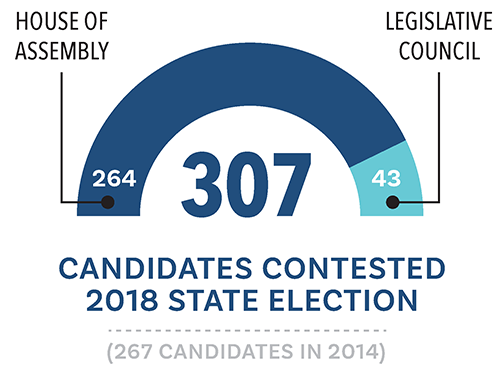
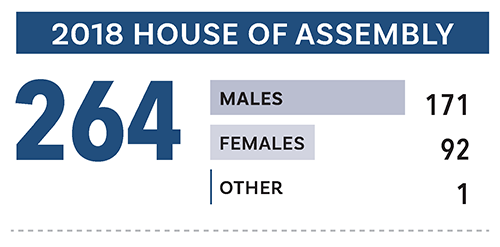
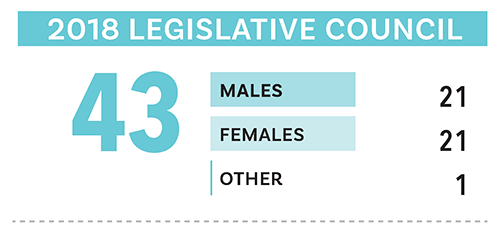
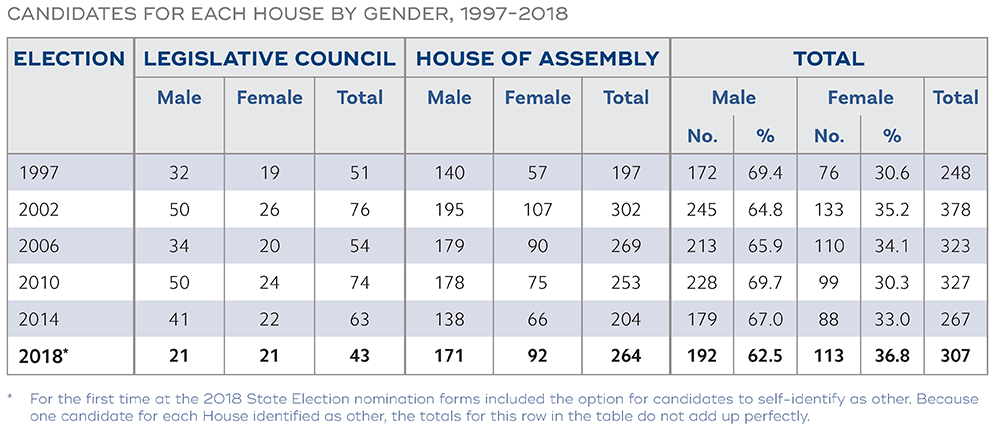
This increase may have reflected the substantial
reduction in the nomination deposit candidates were
required to pay. A total of 43 candidates nominated
to contest the 11 vacancies in the Legislative Council,
compared with 63 in 2014. Across all elections, 288
candidates were endorsed by registered political
parties and 19 candidates stood as independents.
Of the nominations, 62.5% were male and 36.8%
were female, with two candidates self-identifying as
‘other’. The number of female candidates nominating
in 2018 was the highest since 2002 and as a
percentage of total nominations, at 36.8% was the
highest rate of female participation ever recorded in
South Australia.
In late January 2018, ECSA hosted briefings and
information sessions for registered parties and
prospective candidates. There were five briefing
sessions for parties, comprising one each for the
Labor Party, Liberal Party and SA-Best, with a
separate session for all other registered parties, and
one for unendorsed candidates.
The briefings gave parties and candidates an
opportunity to meet and ask questions of ECSA staff
and hear first-hand about the nomination process,
postal vote processing, complaints handling, vote
counting and results.

A CALL FOR LEGISLATIVE CHANGE: ONLINE PORTAL FOR CANDIDATE LODGEMENTS
The lodging and checking processes for
nominations, how-to-vote (HTV) cards and voting
tickets for the 2018 State Election was labour
intensive for candidates, political parties and
key ECSA staff. The processing of nominations
and other lodged election materials within tight
legislative deadlines can be one of the most
challenging parts of a state election.
Over the past two decades, despite advances in
technology, there has been little substantive change
to the manner in which nominations, HTV cards and
voting tickets may be lodged. The process continues
to involve lodgement of paper forms, followed by
manual data entry and multiple rounds of checking
by senior staff. Feedback from candidates and
registered officers included calls for a more modern
method for lodgements.
Technology offers the ability to significantly reduce
the time and resources required for processing
nominations, HTV cards, voting tickets and other
candidate-related information currently collected
in paper forms. It can also allow for electronic
lodgement of forms to enhance accuracy and
streamline quality assurance practices.
For the 2022 State Election, ECSA seeks legislative
support for a comprehensive candidate portal
on the ECSA website containing all the tools that
candidates and political parties need to complete
and lodge their nominations correctly. Within the
candidate portal, each candidate or party’s approved
nomination data can then be used to automatically
populate the fields of HTV cards and voting tickets,
thereby reducing the margin for error. Candidates
and parties will be able to arrange their preferences
and then download a version to provide to their
graphic designers which fully complies with the
regulations. Once prepared, the final HTV cards
would be uploaded to the portal for checking and
lodgement, avoiding issues which some parties
experienced in 2018 with version control and email
lodgement.
That the Act be amended to prescribe a method for the electronic lodgement of nominations, voting tickets and how-to-vote cards to enable more accurate, timely and robust mechanisms that assist and support parties and candidates with meeting legislative obligations.

FUNDING AND DISCLOSURE EDUCATION AND ENGAGEMENT
On 1 July 2015, Part 13A (Election funding,
expenditure and disclosure) was inserted into the
Act. This marked the first introduction of a funding
and disclosure scheme in South Australia and this
State Election was the first to have the scheme in
operation.
In the lead-up to the Election, ECSA delivered a
comprehensive education and engagement program
to inform participants of their obligations under the
new funding and disclosure scheme. ECSA produced
extensive guides and conducted briefing sessions for
political parties, associated entities, third parties and
candidates. Although political parties and associated
entities had been engaged and lodging periodic
returns since July 2015, they still benefited from
education on the increased disclosure requirements
during an election period.
ECSA maintained regular communication with
stakeholders through emails, telephone calls,
lodgement reminders and a weekly Funding and
Disclosure Newsletter. Although some compliance
issues were identified during the election, ECSA took
a collaborative approach and with its close working
relationship with stakeholders was successful in
implementing the funding and disclosure scheme for
the 2018 State Election.
For more information on funding and disclosure,
see Chapter Six.
